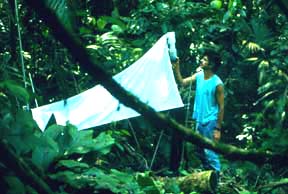|
Malaise Samples
A program of quantitative sampling was initiated in March, 1993. Sixteen areas were selected on a La Selva station map, stratified by soil type (alluvial vs. residual) and forest type (primary vs. secondary). This design yielded four replicates for each soil and forest type combination. Sites were easily accessible from a trail system, but widely dispersed. A Malaise trap (Marris House,with black vertical panel and white roof) was erected in each area. Malaise traps are open-sided tents with a collecting head in which flying or crawling arthropods are trapped and accumulate. The collecting head was a plastic bottle containing 75% ethanol. Malaise traps were placed in light gaps and potential flyways and maintained from March 1993 to March 1994, for a total of 13 months. At the beginning and the middle of each month, the collecting bottle with accumulated arthropods was removed and replaced with a fresh bottle of ethanol.
  
The sampling regime at 4 distant sites (6, 14, 15, 16) was changed after 2 months. Samples were harvested once per month instead of once per two weeks.
New traps were installed and a second series of malaise samples were taken from June 1995 until June 1996. The traps were installed at the same sites as previously, excluding the 4 most distant sites.
One malaise trap was installed at a recent treefall at a swamp edge (site 18), and maintained from August 1997 to December 1998.
One malaise trap was installed at a recent treefall between the lab clearing and the River Station (site 19), and maintained from July 1999 to November 2000.
At some point in time we switched to using 95% etoh in the bottles, but I do not remember when. All sampling during ALAS IV, 2001-2005, was with 95% etoh.
In 2004, ten traps were placed at new locations (20-29) to parallel the sampling taking place at the 300m site (Cantarrana) on the Barva transect. Ten traps were run for the same time as the transect sampling. These traps were also used for flight intercept traps for part of the time, again paralleling the sampling taking place at Cantarrana.
Collection Codes are of the form M/yy/zzz, where yy is a location number (01-16 for the original 16, 18 for the treefall site, and 00 when the sample is not part of a replicated series at one site), and zzz is a three digit sample number. Sample number is a sequential number based on all malaise samples, not the samples of a particular location. Thus a batch of 8 malaise samples taken on a particular day will have 8 sequential collection numbers, regardless from which locations they came. Errors resulted in a few sample numbers (but not entire collection codes) being repeated; these are described in the list of collection codes. When referring to ALAS specimens, it is important to use the entire collection code, not just the sequential number.
Brief descriptions of Malaise trap sites, locations 1-19; click here.
List of all malaise samples, 1993-2004, by collection code.
|






